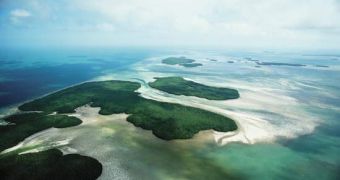Biscayne National Park is located at the southeastern extremity of the North American continent, in southeastern Florida. It comprises 750 km?(300 mi?) of islands, clear waters, reef corrals and mangrove forests, preserving Biscayne Bay, one of the top scuba diving areas in the United States.
The zone was declared a National Monument in 1968 and turned into a National Park on June 28, 1980. 95 % of the surface of the park is located underwater. The mangrove forests protect this submarine paradise from the noise of Miami City, located just several kilometers away. On the east, the park advances to the area affected by the Gulf Stream.
Off the Biscayne Bay, there is a coral island chain named Florida Keys (key comes from Spanish "cayo", meaning "islet"). The park comprises 32 islands with a total surface of 28 square km (12 square mi). These islands rarely overpass an altitude of 2.5 m (8.3 ft). These islets represent the remains of coral reefs that got out of the water with the descend of the sea level along the millennia. The largest of them, Elliott Key, is considered to be formed from coral reef, but the islands located farther north in the park are transitional, being made of coral and sand.
The keys are broken by canals that connect the Biscayne Bay to the Atlantic. The access to the islands is made only through boats and motorboats.
On the islands, the tropical-subtropical clime favors a lush vegetation, dominated by gumbo-limbo (Bursera simaruba), Jamaica dogwood (Piscidia), mahogany, coconuts, palms and vines. The red mangrove tree (Rhizophora mangle) is the dominant species in the mangroves.
On the branches of the trees, many birds install their nests: ibises, herons, egrets, grebes, bitterns, spoonbills, ducks, storks, owls, falcons and vultures. The islands also have a mammal fauna made by raccoons, squirrels, mice, hares and others. But the commonest creature here is the mosquito, which is a plague during the summer months.
But the most impressive is underwater fauna, which turn the park into a major attraction for scuba diving or snorkeling. The Biscayne National Park harbors one of the most northern reefs in the US. About 50 coral species are found in the park, both soft and hard corals. Only the hard corals form reefs. The reefs harbor many species of sponges, algae, fish, crabs, mussels, shrimps, lobsters and starfish. Sponges and mussels act like water filters.
The Biscayne islands are often affected by twisters (hurricanes) between June and November. Up to 50 twisters can occur in 10 years. Florida Keys protect the coast against the twisters. The external reefs are extremely important in slowing down the speed of the waves. The mangroves and the forests of the islands calm down the fury of the wind, as well. The shallow waters of the Biscayne Bay, too, speed down the waves. In fact, the waters of the bay have an average depth of 1.5 m (5 ft).
The oldest inhabitants of the Biscayne Bay were the Tequesta Indians, who fished and hunted sharks, sea turtles and manatees. They knew pottery and used canoes, bows and arrows. Shells of the sea animals were used for making tools, adornments and for trade. Bivalves were a main food source. The diseases brought by the Europeans and the fights between the tribes wiped out this ethnic group almost completely by 1765.
Even if the Spaniards, led by Ponce de Leon, first stepped on Florida in 1513, and detained it for 300 years, the local conditions, not suitable for agriculture, and the remoteness left the Florida Keys uninhabited for long.
Tourists can visit the park in boats endowed with glass floors and walls, can practice windsurfing and sport fishing and can take pictures of the submarine and terrestrial flora and fauna.

 14 DAY TRIAL //
14 DAY TRIAL //